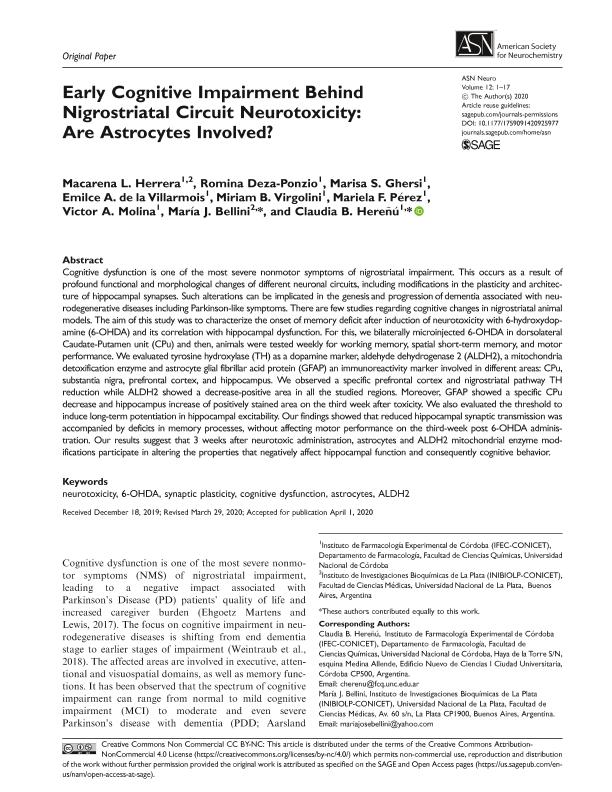Artículo
Early cognitive impairment behind nigrostriatal circuit neurotoxicity: Are astrocytes involved?
Herrera, Macarena Lorena ; Deza Ponzio, Romina
; Deza Ponzio, Romina ; Ghersi, Marisa Soledad
; Ghersi, Marisa Soledad ; Artur de la Villarmois, Emilce
; Artur de la Villarmois, Emilce ; Virgolini, Miriam Beatriz
; Virgolini, Miriam Beatriz ; Perez, Mariela Fernanda
; Perez, Mariela Fernanda ; Molina, Victor Alejandro
; Molina, Victor Alejandro ; Bellini, Maria Jose
; Bellini, Maria Jose ; Hereñú, Claudia Beatriz
; Hereñú, Claudia Beatriz
 ; Deza Ponzio, Romina
; Deza Ponzio, Romina ; Ghersi, Marisa Soledad
; Ghersi, Marisa Soledad ; Artur de la Villarmois, Emilce
; Artur de la Villarmois, Emilce ; Virgolini, Miriam Beatriz
; Virgolini, Miriam Beatriz ; Perez, Mariela Fernanda
; Perez, Mariela Fernanda ; Molina, Victor Alejandro
; Molina, Victor Alejandro ; Bellini, Maria Jose
; Bellini, Maria Jose ; Hereñú, Claudia Beatriz
; Hereñú, Claudia Beatriz
Fecha de publicación:
28/05/2020
Editorial:
SAGE Publications
Revista:
ASN Neuro
ISSN:
1759-0914
Idioma:
Inglés
Tipo de recurso:
Artículo publicado
Clasificación temática:
Resumen
Cognitive dysfunction is one of the most severe nonmotor symptoms of nigrostriatal impairment. This occurs as a result of profound functional and morphological changes of different neuronal circuits, including modifications in the plasticity and architecture of hippocampal synapses. Such alterations can be implicated in the genesis and progression of dementia associated with neurodegenerative diseases including Parkinson-like symptoms. There are few studies regarding cognitive changes in nigrostriatal animal models. The aim of this study was to characterize the onset of memory deficit after induction of neurotoxicity with 6-hydroxydopamine (6-OHDA) and its correlation with hippocampal dysfunction. For this, we bilaterally microinjected 6-OHDA in dorsolateral Caudate-Putamen unit (CPu) and then, animals were tested weekly for working memory, spatial short-term memory, and motor performance. We evaluated tyrosine hydroxylase (TH) as a dopamine marker, aldehyde dehydrogenase 2 (ALDH2), a mitochondria detoxification enzyme and astrocyte glial fibrillar acid protein (GFAP) an immunoreactivity marker involved in different areas: CPu, substantia nigra, prefrontal cortex, and hippocampus. We observed a specific prefrontal cortex and nigrostriatal pathway TH reduction while ALDH2 showed a decrease-positive area in all the studied regions. Moreover, GFAP showed a specific CPu decrease and hippocampus increase of positively stained area on the third week after toxicity. We also evaluated the threshold to induce long-term potentiation in hippocampal excitability. Our findings showed that reduced hippocampal synaptic transmission was accompanied by deficits in memory processes, without affecting motor performance on the third-week post 6-OHDA administration. Our results suggest that 3 weeks after neurotoxic administration, astrocytes and ALDH2 mitochondrial enzyme modifications participate in altering the properties that negatively affect hippocampal function and consequently cognitive behavior.
Palabras clave:
6-OHDA
,
ALDH2
,
ASTROCYTES
,
COGNITIVE DYSFUNCTION
,
NEUROTOXICITY
,
SYNAPTIC PLASTICITY
Archivos asociados
Licencia
Identificadores
Colecciones
Articulos(INIBIOLP)
Articulos de INST.DE INVEST.BIOQUIMICAS DE LA PLATA
Articulos de INST.DE INVEST.BIOQUIMICAS DE LA PLATA
Citación
Herrera, Macarena Lorena; Deza Ponzio, Romina; Ghersi, Marisa Soledad; Artur de la Villarmois, Emilce; Virgolini, Miriam Beatriz; et al.; Early cognitive impairment behind nigrostriatal circuit neurotoxicity: Are astrocytes involved?; SAGE Publications; ASN Neuro; 12; 28-5-2020; 1-17
Compartir
Altmétricas



